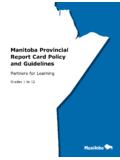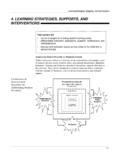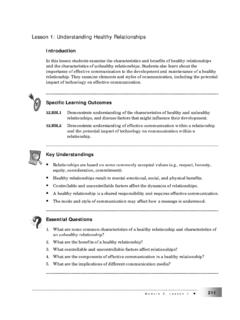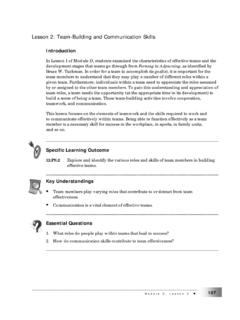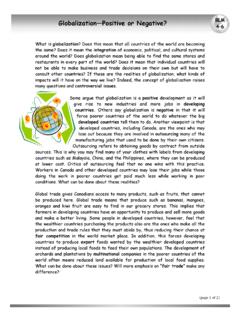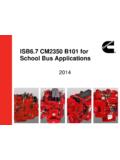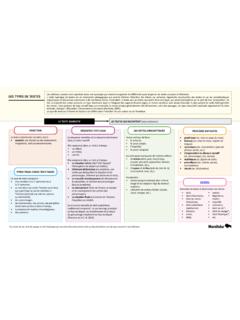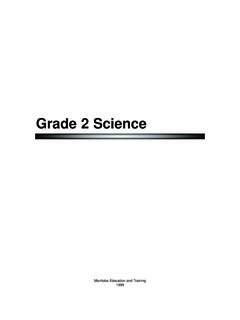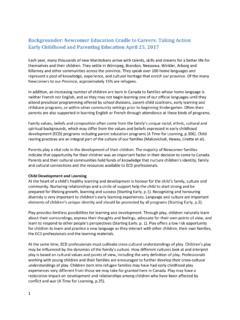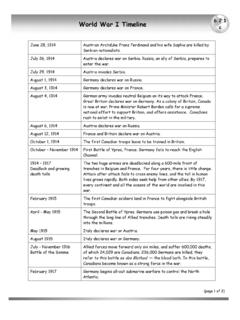Transcription of Grade 5 Science - Province of Manitoba
1 Manitoba Education and Training2000 Grade 5 ScienceGrade 5 Cluster 1:Maintaining a Healthy BodyOverviewThe study of the human body at Grade 5 focuses on themaintenance of good health. Students learn about the role thatnutrients play, and how to plan balanced and nutritious mealsusing Canada s Food Guide to Healthy Eating. Students gainexperience in interpreting nutritional information on food labels,and in evaluating images presented by the media. A study of themajor body systems and their role in the healthy functioning ofthe human body helps students to appreciate the nature andfunction of each, and the interrelationships that exist betweensystems.
2 Students explore how lifestyle choices andenvironmental factors can affect personal 5 to 8 Science : A Foundation for Implementation FORINSTRUCTIONS tudents Introduce, explain, use, and reinforce vocabulary throughout thiscluster. Sort and PredictProvide students with a set of words. Have them work in groupsto predict the meaning of the words and sort them intocategories. Have groups share their categories with the class. Asa class, identify words for which students need more informationto be able to categorize them with clarity.
3 Post these words andclarify them as the study of the human body progresses.(For a BLM of a Sort and Predict think sheet, see SYSTH,Attachment , or Success, p. )5-1-01 Use appropriate vocabularyrelated to their investigations ofhuman : nutrients; carbohydrates;proteins; fats; vitamins; minerals;Canada s Food Guide to HealthyEating; food group; serving size;terms related to the digestive,skeletal, muscular, nervous,integumentary, respiratory, andcirculatory : B3, C6, D1 Teacher NotesPrior KnowledgeStudents have had previous experiences related to this cluster in Grade3, Cluster 2: Materials and Structures.
4 In Grade 2, Cluster 1: Growthand Changes in Animals; in Grade 1, Cluster 1: Characteristics andNeeds of Living Things; and in Grade 1, Cluster 2: The to Kindergarten to Senior 4 Physical Education/HealthEducation: Manitoba Curriculum Framework of Outcomes forActive Healthy Lifestylesfor related learning outcomes andteacher FORASSESSMENTG rade 5, Cluster 1: Maintaining a Healthy BodyGrades 5 to 8 Science : A Foundation for Implementation nutritionalinformation found on food : ingredient proportions,identification of potential allergens,information related to energy contentand.
5 B3, C4, C5, C8 Investigating Food LabelsBring to class a variety of foodstuff boxes/cans that providenutritional information on the labels. Have students look at the information provided list the information that the labels have in common identify the differences that they see give reasons for the information providedExample:Nutrient Content Interpreting Nutritional InformationHave students bring to class a collection of foodstuff boxes/cansand sort them according to product ( , cereal, crackers).
6 Havesmall groups of students each take one set of boxes and orderthem in different ways. Examples: Order the boxes from the greatest to the smallest quantity ofcalories/energy per serving. Order the boxes from the lowest to the highest fibre content. Order the boxes from the lowest to the highest sugar Link:The boxes can also be used to determine perimeter,area, and volume. InformationCerealCrackersSoupProportion/ Serving SizeEnergy/CaloriesProteinFatCarbohydrat esSugarsStarchDietary FibreSodiumPotassiumVitamin ListIngredient ListSUGGESTIONS FORINSTRUCTIONS tudents information using a variety ofsources.
7 Examples: libraries, magazines,community resource people, outdoorexperiences, videos, CD-ROMs, GLO: C6 (ELA Grade 5, ; Math: )5-0-4cWork cooperatively with group membersto carry out a plan, and troubleshoot problemsas they arise. GLO: C7 (ELA Grade 5, )5-0-5fRecord and organize observations in avariety of ways. Examples: point-form notes,sentences, labelled diagrams, charts, orderedlists of data, frequency diagrams, GLO: C2, C6 (ELA Grade 5, ;Math: ) Response Provide students with the following:Food Product AnalysisNutrition Information Per 28 g ServingEnergy150 cal/620 gCholesterol0 mgCarbohydrates15 gDietary gSodium178 mgPotassium386 mgPercentage of Recommended Daily IntakeVitamin E23%Vitamin C15%Thiamine3%Riboflavin2%Niacin10%Vitam in B61%Calcium1%Iron3%Zinc3%Review the nutrition information above.
8 What can you tellabout the product that it came from? Look for: low serving size high calorie and fat content high potassium content relatively high fibre content very few vitamins or mineralsPan Canadian Science Place 5: BodyWorks(Lesson 3)SUGGESTEDLEARNINGRESOURCESSUGGESTIONS FORASSESSMENTG rade 5, Cluster 1: Maintaining a Healthy BodyGrades 5 to 8 Science : A Foundation for Implementation the types of nutrientsin foods and their function inmaintaining a healthy : carbohydrates, proteins, fats,vitamins.
9 B3, D1 Nutrient ResearchUse the Jigsaw technique (Aronson et al, 1978) to have studentsresearch each of the five nutrients: carbohydrates, proteins, fats,vitamins, and minerals. Divide the class into home groups offour members. Have each home group member select one of thenutrients to research. Individuals from each home group thenmeet with members of other home groups who are assigned thesame nutrient, to form expert groups. Each expert groupresearches its own nutrient to determine what it is, where it isfound, and what function it serves in maintaining a healthy , each group expert member shares findings with thehome group.
10 (For strategies to aid students in recording information in theirown words and referencing sources, refer to 5-8 ELA, Grade 5,learning outcome , pp. 262-268.) Graphing Nutrient ContentGive each student one of the foodstuff boxes/cans that the classhas contributed. Have students graph the nutrient of having students put the name of the food on thegraph, have them put it on the back of the page. Suggest thatstudents look at the graphs and predict which food is beingrepresented. SUGGESTIONS FORINSTRUCTIONS tudents information using a variety ofsources.
